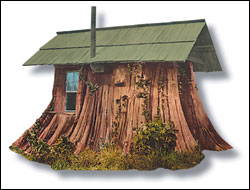SPRING HAS SPRUNG and the giant crap-spewing barges have returned to that Capistrano of the Sound, Elliott Bay. Ah, the cruise ships, part of that so-called “clean” tourism industry that every year seems to flush more and more tourists into our city. Given the economy, we’re supposed to be grateful, and indeed we have spent megamillions to make the tourists happy: new piers, a mall-ified downtown, hotels, trolleys, and restaurants no local would be caught dead in. It creates jobs and keeps some hustle in our bustle. But it costs.
Seattle is a port city, and in that sense the cruise ships are a kind of welcome idea, adding to the diversity of maritime traffic. But these vessels aren’t the charming steamers of old. They’re not shuttling passengers around the Pacific Rim; they’re no mosquito fleet ferrying locals up and down the Sound; they don’t have the old-world elegance and scale of, say, the old Princess Marguerite, which long carried folks to Victoria.
No, these are floating high-rise cities that lug thousands of tourists at a time through some of the world’s most beautiful waterways so they can view the scenery between visits to the onboard casinos.
OK, I’m being a bit unfair, but these tubs are like floating Marriotts, and when they begin to line the seasonal waterfront like pigs at the pastry cart, it’s hard not to wonder what they hell people are thinking about this kind of travel. They’re tourism’s equivalent of the SUV. SUVs aren’t about enjoying nature, they’re about romping around in nature while being utterly oblivious to it. Just check any SUV commercial: The vehicles are shown tearing throughand upthe natural landscape to which they offer “escape.”
In a similar way, these cruise ships use the appeal of the wilderness to offer a backdrop to the real experience on board the ships: spas, luxury dining, gambling, karaoke. These keep wilderness at bay and allow everyone to be oblivious to the fact that their very presence is degrading the natural world that supposedly is being celebrated.
THE RECENT BROUHAHA over the Norwegian Cruise Lines vessel Norwegian Sun discharging 16,000 gallons of raw sewage into the Strait of Juan de Fuca should be a reminder that the cruise business, like others, has a downside, and much of that is borne by the natural environments they exploit. They can’t exactly be honest about it: Come See the Inside Passage, World’s Prettiest Toilet! But the rest of us don’t have to succumb to marketing hype; we can sit here and wonder if this industry is worth it.
For one thing, we need to get over the idea that tourism is inherently clean and that ecotourism is pure. In fact, some of the worst consequences of ecotourismmost of which are unintentional impact the most distressed environments and species. Take, for instance, the mountain gorillas of Africa, which, thanks to sensitive ecotourism, are suffering from numerous human-borne diseases now, including mange, a disease transmitted by hikers’ discarded clothes. In addition, a United Nations report on ecotourism indicated that it actually drives development in sensitive areas.
Too, the Juan de Fuca flush should sensitize us to the problems with our own resident sewage problems. Just days after the Sun discharged into the Strait, an overflow problem dumped vastly more raw poop into the Sound: 190,000 gallons into Tacoma’s Hylebos Waterway. And Victoria continues to pump millions of gallons of raw or barely treated sewage into the Strait every year. There are many potential damaging consequences, some surprising. In recent weeks, a new scientific study into the rising mortality rates of California sea otters determined that one major factor was that many were weakened by parasites that are only carried in the feces of house cats. In other words, all those vegan PETA pet-owners who’ve been flushing Fluffy’s dirty litter down the toilet may be killing off wild mammals farther along the chain.
The cruise lines are exacerbating existing problems, which means we need to hold them to high standards while also improving our own behavior. Most of Puget Sound’s problems are self-inflicted. Last year’s award-winning Seattle Post- Intelligencer series, “Our Troubled Sound,” did a great job of laying out all the ways we treat this unique inland sea as a toxic dump. It’s not the cruise lines’ fault that it is deteriorating. In fact, one could argue that Seattle itself is a kind of cruise ship floating inand soilingthe Northwest environment.
BUT THAT ONLY underscores why we need to consider both the cultural and economic aspects of the cruise industry. Is it one we want to promote? Is it one around which we want to shape our city’s landscape and economy? Do we want to provide safe haven for ships that can legally dump sewage in pristine waters elsewhere, even if not our Sound? It’s particularly important because the waters these ships are cruising are among the last of their kind on the planet.
Perhaps it would be wiser to dock the cruise ships in Bremerton and simply show digital IMAX imagery outside their windows to give people the illusion they are cruising remote waters. I have the feeling that if you didn’t tell them, many passengers would never know the difference. Gently rock the docked ship and their virtual cruise might be just as pleasant as a real one. And a lot better for nature.







